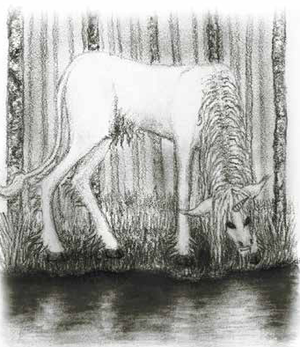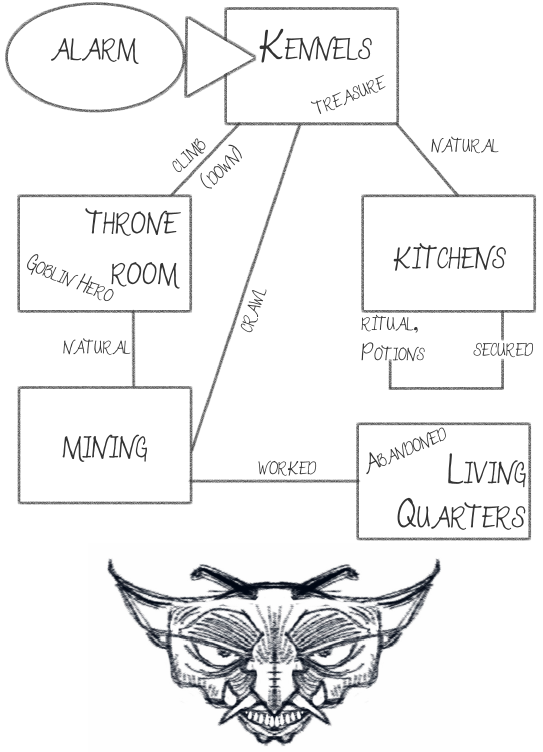Beyond the Wall by GimpInBlack
Mechanics and Characters
Original SA postDoresh posted:
No game system is perfect (though some are significantly more non-perfect than others). What matters is the fun you have with it.
And there has been way too little F&F in here. Let's fix that!
Great idea! And to counterbalance the hilarious awfulness that is Changing Breeds, I'd like to talk a little bit about a game I'm really excited by. Strap on your mother's sword, kiss your father goodbye, and gather your friends behind the stables, because it's time to go
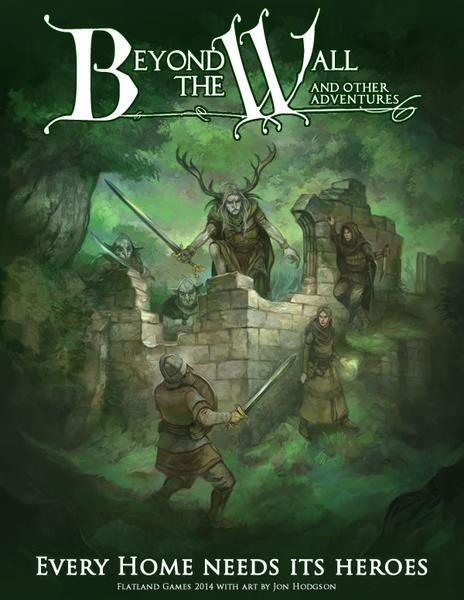
Beyond the Wall , from Flatland Games, is a quick, rules-light OSR-style game of fantasy adventure. The first edition was published as a free game back in 2013, with a full-color, expanded second edition last year. To date, Flatland has released several free updates, including new character options and a new scenario, and the game's first full supplement, Further Afield, just came out. It covers expanding and adapting the systems in Beyond the Wall to long-form campaign play.
Now, since there are roughly a million OSR-style games of fantasy adventure out there, I wouldn't be wasting your time with an F&F unless something set this one apart. What really makes Beyond the Wall special is twofold: first, while the system supports traditional campaign-style play, it's designed first and foremost for low-prep to no-prep one shots and short games. Taking a page from Apocalypse World and its ilk, the game provides players with Playbooks that serve as backstory generator, relationship engine, and character creation all in one go. Roll on a few tables, add up some attribute modifiers, and write down a few skills and not only does your Village Hero or Witch's Prentice* have a complete character sheet, she's got a history, some NPCs who are important to her, and a bond with the other PCs. GMs, meanwhile, have Scenario Packs, which include a threat, its motivation, and enough random events and connections to the players and their relationships to kick off an adventure and provide some satisfying twists and emotional gravitas. All told, with a group of 3-5 players, you should be able to go from zero to playtime in 30-45 minutes.
* Oh my god you guys, the Witch's Prentice is the best playbook. We'll get to why later.
The second thing that sets Beyond the Wall apart is its theme and inspirational material. Lots of OSR games try to take things back to the pulp fantasy of Howard, Leiber, Smith, et al: mighty-thewed warriors and wicked sorcerers, yadda yadda yadda. Not that that stuff isn't fun, but we've seen it all before. Beyond the Wall embraces older children's and young adult fantasy, with the three primary inspirations being the first three Earthsea novels by Ursula K. Leguin, LLloyd Alexander's Prydain Chronicles , and Susan Cooper's The Dark Is Rising series. This is a game about kids on the cusp of adulthood, in over their heads despite their great potential, leaving the comfort and safety of their little village to explore the wide world outside. The Wall in the title, then, is metaphorical. There might be a literal wall, like a palisade around the village or an old wall to the north that keeps the barbarians at bay, but really we're talking about the line between safety and danger, childhood and adulthood, and all that coming of age story stuff. In fact, while I adore the full-color second edition cover at the top of this post, I think the first edition's pencil-sketch cover is wonderfully evocative of this motif:
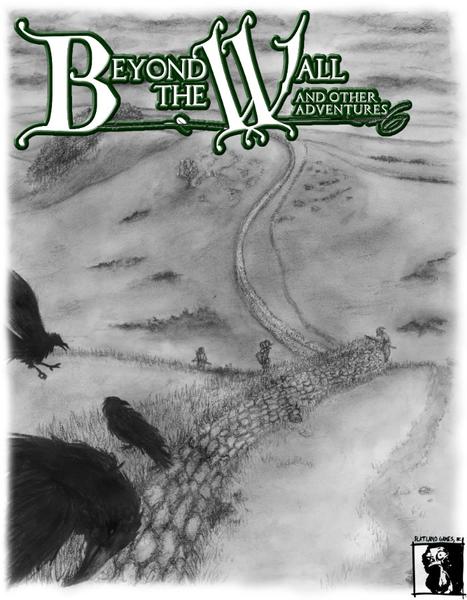
Just look at that picture and tell me you don't want to go exploring.
God, I love that. The wall stretching off into the hills, the three tiny figures in the middle distance, those crows... it really gives you a sense of the atmosphere of the game. So, let's dive in, shall we?
After a quick introduction that lays out the points I just talked about and breaks down the contents of the book (Core Rules, How to Play, Spells and Magic, and finally the Bestiary), we're off into the core rules. The core mechanics of Beyond the Wall are pretty simple; the book devotes about 30 pages to them, but you can condense the essentials down to a page and still have enough room for your class progression chart and the attribute bonus chart to boot.
What the Numbers Mean
The first "chapter," if you can call a 4-page glossary a chapter, is devoted to explaining the various numbers on a character sheet and what they mean. For all that the Introduction told us that Beyond the Wall is written for people who are experienced with RPGs, this section is still a good primer. I'm just going to hit the highlights here since I'm pretty sure goons reading this thread are at least passing familiar with D&D.
Beyond the Wall has three classes: warrior, rogue, and mage. There are no subclasses or kits or anything like that, although some of the Playbooks we'll see later combine two classes in interesting ways (and the Appendix gives guidelines for making your own "multiclass" characters). Level ranges from one to ten, with even level one representing characters a cut above normal folk--your naturally-gifted young swordswomen, clever tricksters, and hell-raising witch's prentices (seriously you guys, the best playbook ). Level 5 is about where you hit fame and fortune, while level 10 is "hero of song and story" territory. In true old-school fashion, the classes are partly "balanced" by having different XP rates: the rogue levels up fastest, followed by the warrior and then the mage. Normally that's not a system I'm a huge fan of, and level matters a bit more in Beyond the Wall than it does in old-school D&D, but it does give the system one more lever to pull in terms of tiering class abilities. We'll talk a bit more about that when we get to the class writeups in a bit.
Ability scores are the same six we all know and love, but Beyond the Wall wisely eschews the pages and pages of tables old D&D was so enamored of and goes for a simple universal attribute modifier like later editions. It's not quite the same table as 3e, with 9-12 being the +0 modifier range and the cap being +3 at 18, but since the game uses a roll-under mechanic for attribute checks rather than a "roll, add modifier, and compare to DC" mechanic, modifiers come up a lot less. Most attribute modifiers only apply to one or two things, and mostly they're what you'd expect: Strength to melee attack and damage, Constitution to hit points per level, etc. The only two that stick out as a bit weird are Wisdom and Charisma: Wisdom adds to saving throws vs. mind control (only vs. mind control, and this is the only place an attribute modifier alters a saving throw), and Charisma adds to the number of NPC followers you can have. That one is mostly weird because hiring a bunch of sellswords to follow you into a dungeon feels more like a D&D trope specifically, not something you see much in the source fiction. Both kind of feel like nobody could think of particularly good uses for either attribute that weren't checks, so these were just sort of thrown in there.
Beyond the Wall's alignments are downright Moorcockian: Lawful, Chaotic, and Neutral. Again, feels a bit out of synch with what I remember of the inspirational fiction, but at least the text makes a point of saying that Lawful and Chaotic aren't just synonyms for Good and Evil: Lawful characters can be iron-fisted tyrants, and Chaotic characters can be freedom fighters. Although:
Beyond the Wall posted:
A brave warrior who wanders the land, righting wrongs which bother him and ignoring those in which he has no interest, is a chaotic character
This guy still kinda sounds like a dick to me.
Combat-related stats are pretty straightforward: Initiative is a static value equal to your level + Dex bonus + a class bonus; you don't roll, you just go in initiative order. Hit points are exactly what you'd expect, and the game uses Base Attack Bonus and ascending Armor Class as all right-thinking d20 games should. It does, however, hew to tradition with saving throws: Poison (also used for paralyzing effects and anything that attacks your physical toughness), Breath Weapon (also used for anything you need to get the hell out of the way of), Polymorph (oddly enough, only used for forced shapechanging), Spell (just spells), and Magic Item (also just magic items). Supposedly this is so it's easier to plug-and-play your favorite classic D&D modules, but ehhhh... five saves is too many and remembering that you roll vs. breath weapon to dodge a collapsing wall is weird and counterintuitive, to say nothing of the old "which save do I roll if a spell gives the wizard a paralyzing breath weapon?" debate. Fortunately, the Appendix has rules for replacing the saves with Fortitude, Reflex, and Will, which I highly recommend using.
Finally, the last thing in this chapter is Fortune Points. All we're told here, though, is that only PCs have them and they can be spent to give you rerolls, help out a friend, or cheat death. Despite Skills being A Thing that we'll talk about soon, they aren't mentioned anywhere in this chapter.
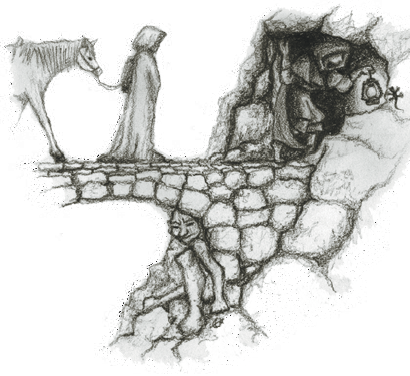
Most of the art in the book is in this pencil-sketch style, with little hints of the supernatural lurking just out of sight. I love the surprise bridge troll.
Making a Character
Despite the fact that the game's designed to kick things off with Playbooks, we get a simple "quick character creation" option for if we're not using Playbooks because we hate fun. (No, the book doesn't say that, but come on.) Character creation fits on a single page with room for that lovely little bridge troll illustration. Each of the three classes fits on a single page after that. Have I mentioned that I really like how concise and slick this game is? Anyways, it's about what you'd expect: 4d6 drop lowest six times, assign to attributes as you like, then pick a class and alignment. This is the first time we hear mention of Skills , and we'll get into them more later, but basically, when you have a relevant skill, you get a bonus to attribute checks. Skills are freeform, and you can either have two skills at +2 or one skill at +4. If languages are important in your game, you can pick a few based on your Int modifier (since the setting is at best an implied one, you'll want to kibbitz with the rest of the table to figure out what languages there are and if they matter). Finally, every character starts out with some basic adventuring/survival equipment, any tools they need to practice their skills (though not necessarily a full workshop--an apprentice blacksmith probably has his hammer and tongs, but he doesn't own a forge or anvil), and 4d6 silver coins to buy other stuff with. 4d6 isn't a lot of money, but it'll probably buy you some leathers and a light weapon at least.
Character creation forgets to tell us how many Fortune Points we get, but spoiler alert, it's three unless we're a rogue.
Warriors are exactly what you'd expect from an OSR game: d10 hit dice, +1/level BAB, no weapon or armor restrictions (actually, no class has weapon restrictions, which is nice). At first level they get Weapon Specialization (+1 to hit, +2 to damage with a chosen weapon, and they start with that weapon for free), and a choice of one of five Knacks . Knacks are small combat boosts like +1 to AC or +1 to all damage, or picking up another Weapon Specialization. They get additional Knacks at 3rd, 6th, and 9th level, and they can take the same Knack more than once.
Rogues aren't actually the traditional "thief" class. They can be, but really they're there to model any hero who gets by on wits, talent, and blind stupid luck more than skill at arms or mystical acumen. They get a d8 hit die, and a +2/3 per level BAB--but unlike the "medium" BAB progression in 3rd Edition D&D, the bonuses round down instead of up . In other words, the rogue's BAB goes +0/+1/+1/+2/+3 and caps out at +6 instead of +0/+1/+2/+3/+3 and capping out at +7. It's a small change, but one I'm kind of baffled by: rogues are supposed to be halfway between warriors and mages in terms of fighting ability, but by raw BAB the rogue doesn't pull ahead of the mage until level 5. The faster XP rate does make up for that somewhat, but still. Anyways, rogues can wear any armor lighter than plate (though it's not clear whether this means "full plate" or "chain and breastplate"), and their chief advantages are extra skills and fortune points: rogues start with four skills, and automatically learn another one every odd level. They also start with 5 Fortune Points instead of 3.
Mages do magic stuff. The magic in Beyond the Wall is more folksy and subtle than a lot of D&D-style games, but in a pinch they can still do some pretty flashy stuff. Mages get a d6 hit die, 1/2 their level for BAB, and can't wear any armor. Sorry, mages. Unsurprisingly their big advantage is magic, which comes in three flavors: cantrips, spells, and rituals. The magic system in Beyond the Wall is fantastic, and we'll talk about it in a lot more detail in a later update. Mages can also sense magic in a person, place, or thing, but it requires a few minutes and intense concentration unless we're talking about seriously big magic.
Next up we get a very short equipment list. Mostly pretty standard fantasy adventuring stuff; worth noting is that weapons are grouped by damage die and cost, so you can flavor your weapon as pretty much whatever. Personally, I would have just given each class a damage rating and had done with it, but this is a good compromise for old-school type gaming. Armor is similarly simple: an AC bonus and a price. Beyond the Wall doesn't worry about encumbrance or armor check penalties or anything like that, and rightly so. Also worth mentioning is that if you're using the quick character creation rules above, it's very likely that only the warrior will start with a d8 or d10 damage weapon, since they start with their specialization weapon for free. And nobody starts with better than leather armor and a shield for armor: the next step up from your 5 sp leather is 75 sp chain mail. Hope that Dex bonus works for you. It's subtle, but a nice way of reinforcing why warriors are still likely to have the best gear.
Normally at this point I'd pause to create a sample character, but that'll be way more fun to do in the next section, with the Playbooks, so lets press on!
Hirelings and Allies
Like I mentioned earlier, this feels kind of like a holdover D&Dism that doesn't really need to be in Beyond the Wall . Still, it's short and simple enough: hirelings are people you pay to do stuff for you, and they usually don't need stats or anything. Allies are more potent NPCs who are your trusted friends; they're usually about two levels lower than you are, and usually you and the GM will share the job of playing them. They also make handy potential replacement PCs if necessary. The rest of this chapter is just guidelines on things like price and availability of hirelings. Nothing super interesting.
Rolling the Dice
Finally we get to the rules! Normally I'd give a game crap for not putting the rules up front, but they're simple enough (and familiar enough to the target audience) that I'll give it a pass this time. Anyways, with the exception of combat and saving throws, pretty much every action you'd attempt is a simple d20 roll, trying to equal or roll under a relevant attribute. Beyond the Wall takes a very simple approach that pretty much anybody can try pretty much anything; actions being contingent on having a Skill is very rare. Penalties usually come in -2, -5,and -10 flavors, but if a task is easy enough to grant a bonus, you should probably just let it happen. Skills, of course, give a bonus of +2 or +4, depending. Given how much story game influence the game shows elsewhere in its DNA I would have liked to see some word count devoted to concepts like failing forward or succeeding at cost, but all we really get is the old "only roll for stuff that's dramatically important" chestnut.
Friends helping each other is a big part of the stories Beyond the Wall emulates, and the game has a simple system for modelling it. Basically, if you have a relevant skill for a task another PC is attempting, and you can describe how your character is helping, your friend can borrow your skill bonus for the action. Simple, flavorful, and cool. In the event that the whole group is collectively trying to do something, Beyond the Wall credits Luke Crane and Burning Wheel for its "loudest and slowest" rule. If a bunch of characters need to, say, notice the sleeping troll before they stumble into its camp, sneak through the troll's campsite without waking the beast, or run away from the recently-woken and very angry troll, have the character with the lowest attribute roll for the whole group. The more-gifted PCs can (and probably should) assist.
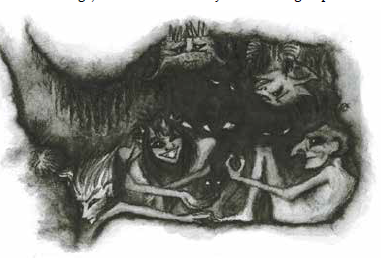
Pictured: group activities. Look at the little guys!
Finally, Fortune Points: you can spend a Fortune Point to reroll any failed roll, help a friend out even if you don't have a relevant skill, or stabilize at 1 hp if you're dying. They generally only come back between adventures.
Combat is about as simple as it gets in a D&D clone: no positioning or movement rules, just attack rolls vs. BAB and damage, with attribute checks covering everything else. PCs heal very slowly: 1 hp per night of rest, but it has to be a full night's rest, you can't stay up to keep watch. If someone has a Healing skill or the like that can go up to 2 hp, but otherwise it's "hope you find a magic well that heals the wounded."
True Names
This is the first place where the game mechanics really speak to the fairy tale vibe of the source material. Demons, spirits, faeries, and the like have true names they guard closely and which give power over them. If you speak a creature's true name, you get a +5 bonus on all actions against it and all saves against its powers. Mages with the right cantrip can also bind and command them, and some rituals require true names to be effective. If you know an ally's true name, you can call it out to improve the result of any magical healing or give them a bigger bonus when you help them out--but you have to actually call it out, so better hope nobody's listening.
So how do you find out something's true name? Well, nobody really just knows true names--at least not PCs--so any roll (usually Int or Wis) to figure them out actually gives you a clue for where you might find someone or something that can tell you. So you're not going to just happen to recall the true name of the Queen of Air and Darkness, but you might remember your Nana telling you stories of Old Myrrdwyn who lived beyond the Flying Falls and knew the name of everything that set foot in his woods, and then you're off to the races to find the Flying Falls and the grumpy old hermit.
Finally, most of the time human beings don't have true names, but if you want (and why wouldn't you?) you can say that human children receive a true name, usually at a coming of age ceremony. If you go that route, it's up to the individual players to decide if their characters have received true names or not. And if there's a plot hook more "YA fantasy" than "worried about my upcoming coming of age rite," I don't know what it is.
The Sorcerous Arts
The last section of the core rules before the optional Appendix gives us rules for the three types of magic. Actual spell lists are later, but here's how they work.
Cantrips are minor, freeform spells, like the ability to see the unseen, conjure lights or sounds, or being preternaturally friendly with animals. Casting a cantrip requires either an Int or a Wis check, possibly with a penalty if you're pushing the bounds of the spell or trying to do something very specific. It's easy to summon a light on the end of your staff; it's less easy to create a dozen bobbing, flickering witch-candles to lead your enemies down the wrong path. If you botch the roll, you have a choice: either you're magically exhausted and can't do any more magic until tomorrow (that also means any active spells you had going immediately end) or the magic goes awry in some inconvenient fashion. Maybe your mage light flares up and blinds you for a minute, or those now-friendly animals won't leave you alone. Mages start out knowing two and very rarely learn more.
Spells are most like what you know as D&D magic. In Beyond the Wall , though, spells have no levels. They're all of a piece in terms of power level, and mages can cast a number of spells per day equal to their level. Spells don't have any activation rolls or components, they just happen. Mages start knowing two and can learn more by studying from books or with a teacher.
Rituals are big, powerful, and slow . Rituals do have levels, from 1 to 10, and you have to be at least that level to cast one. Rituals take one hour per level to cast and have pretty steep material component requirements, which can form the seed of a mini-adventure. Like cantrips, rituals require either an Int or a Wis check to cast, but a failure here means you get the result you wanted (more or less) but something goes wrong and creates a new problem you have to solve. Mages start with one ritual and can learn more through study. They can also cast rituals they don't know from a book or a scroll, but at a -10 penalty. In other words, "apprentice grabs a spellbook he shouldn't have and wreaks havoc" is a viable plot hook. Personally, I'd be inclined to waive the level requirement for casting from a book/scroll, but that's just me.
I really, really love this magic system. It feels true to the source material while still giving the mage a limited arsenal of "holy shit" effects, and every single ritual has enough inspiration for at least two sessions' worth of story. The spell lists, which we'll get to in about two updates' time, are really evocative and actually feel magical, rather than feeling like a grab bag of super powers. A few D&D staples like burning hands, magic missile, and web are still in there, but just the nature of spells makes casting them feel more like a last-ditch effort, like Gandalf making exploding pine cones in The Hobbit , than like a fantasy artillery turret. I've never been much for playing casters in D&D type games, but in Beyond the Wall I'm really tempted.
Appendix: Optional Rules
The last couple pages of the Core Rules section cover some optional rules, including the aforementioned Fortitude, Reflex, Will save option, brief rules for playing elves, dwarves, or halflings if you want the classic fantasy races, and creating multiclass characters. Multiclass characters are basically constructed by mishmashing features of two classes together, trying to keep a balance between picking the best options and the worse option for things like BAB, hit die, and armor restriction. It's simple enough and mostly "eyeball it until it feels right;" we'll see more examples in some of the Playbooks. Here we get one example multiclass character:
The Elven Highborn is a combination of warrior and mage. She gets the warrior's BAB and saves, a d8 hit die, and can wear any armor lighter than plate. She loses the warrior's Knacks, but instead gets the ability to cast cantrips and rituals, but not spells. She also gets the elven racial abilities: the ability to see in all but pitch blackness, a +2 bonus to command or impress faeries, and immunity to nonmagical disease and poison. As an elf, though, she starts with one fewer Fortune Point than other characters.
And that's the core rules for Beyond the Wall in a nutshell. This post went on a little longer than I meant it to, but the individual chapters are all so short it was kind of easier to just plow through in one go. Overall, despite a couple of quirks, I really like the mechanics at work here. It doesn't do anything really revolutionary, but it knows exactly what to keep and what to jettison to make the game play the way it's meant to. The really cool stuff, though, will come next update.
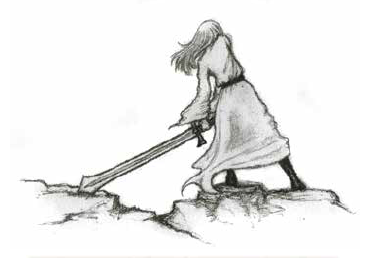
Next time: How to play, playbooks, scenario packs, and creating the village.
Playbooks and Scenario Packs
Original SA postCome with me on a journey back to a simpler time. A time when nature was a thing to be respected, feared, and endured, not used as a half-assed justification for murder and public pooping. A time when a loyal hound was your faithful hunting companion, not your fuckbuddy. That's right, it's time for more
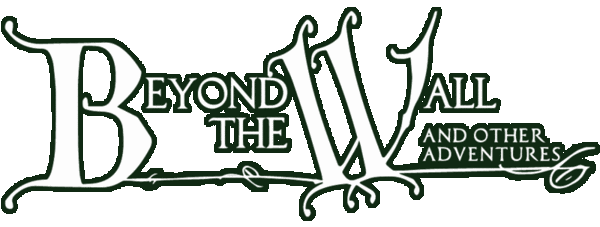
Now that we've got the core rules out of the way, it's time to delve into the aspect of
Beyond the Wall
that really sets it apart: character and scenario creation, and getting the game itself kicked off. The introduction lays out the thinking behind all this pretty clearly: long, sweeping campaigns are great and all, but a lot of us (particularly as we get older, start careers and families, and so on) just can't commit the time for a weekly, bi-weekly, or whatever game, let alone GM prep time between sessions. Thus,
Beyond the Wall
gives us the tools to create reasonably fleshed out characters, a setting, and an adventure that should be playable in a single 3-4 hour session of play.
The second reason, and the one I actually find more interesting in terms of "things to think about when writing an RPG book," is that a lot of tabletop RPGs don't often provide much in the way of tools to help you get playing "out of the box." At best you might get a collection of pregen characters and a canned sample adventure, but that's only really good for one game. Even games like
Apocalypse World
or
Trollbabe
(which I should really finish my F&F review of) rely heavily on the GM's improv abilities to get playing right off the bat.
Beyond the Wall,
"Playbook" terminology aside, actually reminds me more of
Fiasco
: prompting story by giving you a bunch of random tables full of short, evocative descriptions that are concrete enough to run with but also open enough to riff on.
The introduction wraps up with the caveat that the Playbook rules completely replace the quick character creation rules in the previous section. Which is a good caveat to have, because in at least one instance, Playbook-created characters end up breaking the rules in that section: depending on how you roll, you can end up with a third (5th for rogues) Skill using the Playbook tables.
Playbooks and Scenario Packs
Okay, we've talked a lot about Playbooks and Scenario Packs so far, but what, exactly, are they?
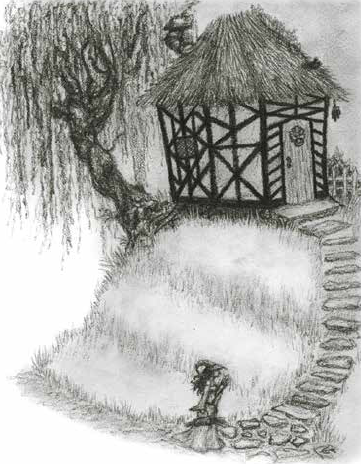
Pictured: The Best Playbook
Character Playbooks
are very similar to the playbooks in
Apocalypse World
or the skins in
Monsterhearts
: a self-contained package that encompasses an archetypal character (the Village Hero, maybe, or the Nobleman's Wild Daughter if you want to play Arya Stark). Each gives you your starting ability scores (usually two at 10 or one at 12, the rest at 8), and by the time you've gone through all the tables in your playbook, you'll also have your final ability scores, skills, all your class features, starting equipment, and at least the skeleton of a backstory and relationships with the other PCs and your village's NPCs. Because
Beyond the Wall
is a game about young people going off and having adventures in the wild, all the playbooks start with the assumption that the PCs are young, talented, but not-truly-tested people, all of whom grew up in the same village and who have been best friends since childhood. Think the very start of the
Wheel of Time
novels before shit went off the deep end and the main character got three super hot wives, and you've got the idea. One of the free expansions Flatland Games has released,
The Nobility
, tweaks this a bit and allows you to create sons and daughters of the local lord, but even then their manor house should be in or very near the village and the noble kids should be friends with the village kids. The core book provides six: The Village Hero, The Untested Thief, The Would-Be Knight, The Young Woodsman, The Self-Taught Mage, and the Witch's Prentice.
Each Playbook consists of seven tables in two sections. The first three tables represent childhood, and they're the same for every Playbook (well, the Nobility gets a modified version of the first one, but otherwise). The intent of having them be the same is to create some connections among the PCs. If two players roll "your parents were merchants," that probably means those characters are siblings--or maybe not, and their parents were business rivals. The golden rule here (and throughout this process really) is: "It's a small village. If two Playbook results describe a similar character, they're probably the same person."
Example: Table 1 asks you to roll 1d12 to answer "
What did your parents do in the village? What did you learn from them?
" If you roll a 4, "Your family worked a small farm outside the village." You gain +2 Con, +1 Wis, +1 Cha, and Skill: Farming. A 7, on the other hand, means "Your parents ran the local inn. You grew up meeting many travellers and hearing their tales (+2 Cha, +1 Int, +1 Dex, +1 Wis)."
The next four tables are where the Playbooks differentiate themselves, and describe how the character became a warrior, rogue, or mage. Typically you get a skill and one of your class features defined by the playbook, then roll on the tables to fill in the rest and modify some more attributes. One of the tables describes an event that both you and one of the other PCs were part of, and gives both of you an attribute boost, so no matter what you're guaranteed to have a relationship with at least two other characters.
Example: The Would-Be Knight says: "As you came of age, you began your quest to become a great knight. You become a level 1 Warrior. You gain the class abilities
Weapon Specialization
and
Knacks,
and the skill
Riding.
The tables below will further define your class abilities." The first table asks you to roll a d6 to answer "
How did you begin your quest?
" You might roll a 1 and learn that "Raiders from the north sometimes reach the village, and you were always the first volunteer in the forces which defended against them." You gain +3 Str and Skill: Command. Or you might roll a 5: "When traders from the south came to the village, you found an old warrior’s training manual and you studied it every day thereafter." You gain +3 Int and Skill: Military History. Other tables will tell you what weapon you're specialized in, your Knacks, etc.
The playbooks also have the occasional icon (either a hand or a map) next to the tables, which indicate that at this point the player should add an interesting person or location to the Village Map (which is just a blank sheet of paper with a masrk for "the local Inn" in the middle; players and GMs can add stuff to it throughout the process). The thing they add can be inspired by the table they just rolled on, but doesn't have to be. It's a classic way to not only move some of the heavy lifting off the GM, but also get the players invested in the setting. Finally, you get a preset bit of equipment, usually some basic adventuring gear, maybe a weapon or armor, and at least one odd little trinket.
As a brief aside, yes, the Playbooks are all randomized. The rules
do
allow you to ignore the result of one out of your seven rolls and pick something from the table instead, but otherwise it's all random. While the book doesn't expressly say so, it seems to me you could probably let players pick without breaking things too horribly, though you might see slightly higher primary attributes that way, if your players are more system-focused than story-focused. The book
does
tell us that, while it's not terribly likely it
is
possible to end up with one attribute in the 18-20 range, or even higher. Regardless of rolls, though, the highest any attribute can start is 19, and any points in excess of that are lost. Sucks, but a 19 attribute is enough reward in its own right.
Scenario Packs meanwhile, are the same thing, but for adventures. The core rulebook includes two: the Angered Fae (somebody pissed off the faeries and now it's up to you to make things right!) and the Hidden Cult (your neighbors are Chaos-worshiping lunatics, oh no!), with the Goblin Infestation available as a free download. They've got some prompts you might expect, like random lists of names for when you need a quick NPC name and various "what's the core of the problem?" tables, but my favorite thing is the blank table. The idea is, as the players are going through their Playbooks and establishing important NPCs, you fill those names in on the table. Then, when you need an NPC for some plot point (maybe to figure out who's in the cult or who pissed off the Fae Lord, or just "whose house do the goblins set fire to?") you can roll on the table and boom! Instant personal stakes. Scenario Packs also have random events to fire off if the momentum starts to flag, some scene-setting preliminary events that draw the PCs into the story (and provide a handy place to teach attribute and skill checks), and suggestions for hooks to extend the story into future adventures, if that's your bag.
Example: The Angered Fae Scenario Pack suggests throwing a random, seemingly unrelated problem within the village into the mix after about a half hour if things are lagging. Maybe "Someone of import to the characters is going through an extremely difficult delivery. The witch needs help of some sort to get her through it." Or maybe "An ancestral feud has been rekindled, and the entire village is split over the matter. Worse, the characters’ families are on opposite sides of the quarrel."
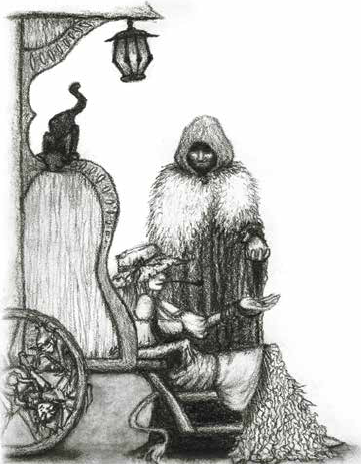
Future adventure hook: "Fuck you, got mine.'
Getting Ready to Play
This section is pretty straightforward, outlining the jobs of each player during the setup phase. Players, obviously, should be rolling on their Playbook tables and recording the results, but more importantly they should be talking about what their results mean, kibbitzing with the rest of the table to flesh out the story and relationships, and so on. The GM has some tables to roll on too, but mostly she should be guiding the players and taking notes on
everything.
Everything the players come up with here is potential fodder for the adventure. The last thing to do is to have each player roll on the Recent Events table for the Scenario Pack. These are short, inciting incidents that include an attribute check that might give the players some advantage in the story if they pass, or create complications if they don't. The PC to their left is also involved somehow, and can help out with skills or Fortune Points. Each scenario has 15: 12 on the table and three "special events" that only kick in if players roll a duplicate event.
Example: Again in the Angred Fae Scenario Pack, you might start off with this:
Unlikely couples have been falling in love throughout the village as a result of faerie magic. Test Charisma (gossip related skills may help).
Success:
you learn that one member of each of these new couples has recently angered a wisewoman in the forest.
Failure:
your favorite cousin falls in love with someone you disapprove of.
Or this:
The village well is filled with wine and you are sent to the witch to ask about it. Test Charisma (social skills may help).
Success:
the witch tells you to save some of the wine; begin the game with two healing potions.
Failure:
the witch turns the wine back to water, but not before the whole village gets drunk.
If someone rolls the "well filled with wine" result again, they might instead get this:
Your faerie godmother came to visit you last night and said that she takes pity on the village. Test Charisma (socializing skills may help).
Success:
she gave you a blessing which allows you to see through all faerie illusions for this adventure.
Failure:
You accidentally insulted your godmother, who left saddened and said she would not bother with you again, but not before giving you a token which grants +1 to all saving throws against fae magic.
Finally, the Scenario Packs helpfully contain a couple pages of appropriate monsters if you need to throw a fight at the players on the fly.
Running the Game
This is a very brief GMing advice chapter. Not a lot here, and more than anyplace I think this is where the game shows it's geared more toward experienced gamers. The main bullet points are Keep Things Moving (don't let things lag; if the players seem stuck throw a new problem at them), Make it Personal (again, use the stuff in the Playbooks and the important people and places the PCs come up with when you need stuff to happen), and Avoid Illusionism (let the PCs' choices matter). There's also a nice little essay on the tone
Beyond the Wall
strives for (gritty, but not grim: the peril is real, but not omnipresent, heroes
can
save the day, and even in the most dangerous places there is beauty and enchantment) and this delightful sidebar:
Special Items posted:
Many of the Character Playbooks give some truly odd items to a starting character: a branch from the Dark Heart of the Wood, an engraved ring, etc. These trinkets may be useful or not, but they are a great source of hooks for the gamemaster.
Often, in the source fiction from which Beyond the Wall draws inspiration, heroes find that they have held something special all along which is useful to them. You might find it useful to have one or more of these trinkets be minor magical items which are important in the adventure.
For instance, perhaps the branch which the woodsman pulled from a twisting hawthorn in the forest is actually a charm against the fae, and will hold them at bay for several rounds in a dangerous combat. Or maybe the nobleman’s daughter has been holding on to an ancient standard which has the power to rally the men of the village to her side in the most dire moment of an attack from the north.
This works best if you plan it at the start of the game and give the players hints, but don’t be afraid to pull it out at the end if the players get in a serious bind and it’s needed.

Next time: The obligatory sample character creation post! Actually, hell, I'll go through a whole Scenario Pack prep just to show how all of this works. We'll definitely be making a Witch's Prentice, because hell yeah, but I'll let the thread vote on two other compatriots and which Scenario Pack to use. So, thread, how about it? Pick two from the following Playbooks:
-
The Village Hero
-
The Untested Thief
-
The Would-Be Knight
-
The Young Woodsman
-
The Self-Taught Mage
-
The Angered Fae
-
The Goblin Infestation
-
The Hidden Cult
Character Creation
Original SA post
Okay, let's get this game started. We're making three characters and setting up the Angered Fae Scenario. First off, let's take a look at our heroes and their playbooks.
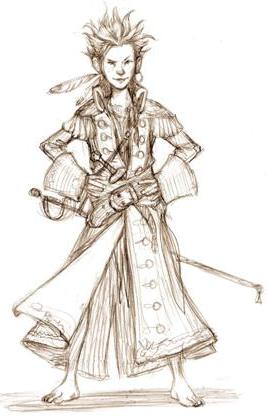
The Untested Thief
Some young would-be adventurers get by with their sword arm or with words of power in the language of magic, but you need neither. The world is full of things to see and enjoy, and your fi ngers are more than quick enough to let you have what you like.
You are deft and quick. Your Dexterity begins at 12, and all of your other ability scores begin at 8.
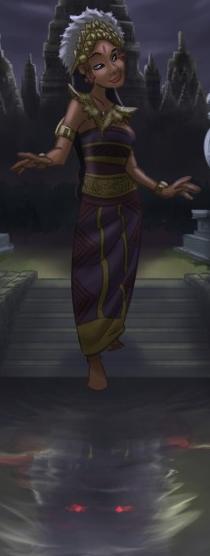
The Self-Taught Mage
You were always a bright child, and loved stories of ancient wizards and sorceresses who mastered the arcane arts. Unfortunately, there was no one around to teach you such things. In fact, sometimes you wondered if the stories of magic were even true. When you came of age, you found an ancient tome and decided to find out for yourself.
You were the brightest child in the village. Your Intelligence begins at 12, and all of your other ability scores begin at 8.
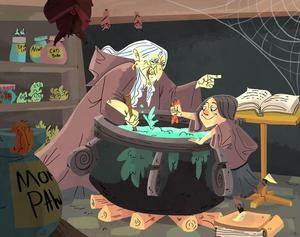
The Witch's Prentice
Every great mage was a student once. Some say the true heart of magic is the simple, practical work of the village witch. Your village, like many, had its own crone who tended the sick and blessed the fi elds. She chose you as her apprentice.
You are naturally intelligent and thoughtful. Your Intelligence and Wisdom begin at 10, and all of your other ability scores begin at 8.
For the sake of stuff that comes up later, we'll assume that's the order they're sitting in, left to right. Now, the first section is Childhood: Since these are shared across all the playbooks I'm going to do them by question, then switch to by character for the class-specific stuff. Oh, and I guess these kids need names, too. Luckily, the Scenario Pack has a convenient table of random Welsh/Celtic names, so I'll just roll on that.
Our Untested Thief is named Arawn .
Our Self-Taught Mage is Keelin .
Our Witch's Prentice is Cait .
Those all seem good to me, so let's start the action!
Childhood
1d12 What did your parents do in the village? What did you learn from them?
 Your father was the local smith and taught you both hammer and bellows. +2 Str, +1 Dex, +1 Cha, Skill: Smithing
Your father was the local smith and taught you both hammer and bellows. +2 Str, +1 Dex, +1 Cha, Skill: Smithing
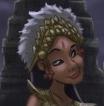 You are an orphan. Things were hard for you. +2 Wis, +2 Con, +1 Int
You are an orphan. Things were hard for you. +2 Wis, +2 Con, +1 Int
 Your father or mother kept the old stories. Your head is filled with them. +2 Int, +1 Cha, +1 Wis, Skill: Folklore
Your father or mother kept the old stories. Your head is filled with them. +2 Int, +1 Cha, +1 Wis, Skill: Folklore
Not a whole lot of commonality in the backgrounds there, but maybe Keelin earned a roof over her head from time to time tending the forge-fires, or Cait liked to scare Arawn with tales of the dead kings in the old barrows outside town.
Also at this stage, everybody gets to add a location of note to the village map. Arawn goes for the obvious and picks "My Da's Smithy," and if it wouldn't be just talking to myself here I'd start asking about their relationship and so on. Keelin, already thinking ahead to her class features, adds a mysterious, ruined tower fort on a hill half a day's walk from the village. The locals call it the Breekintoor, and they say it used to be the home of a great and wise druid of the old days. Cait really likes the idea of ghosts and spooky happenings, so she adds Kingsbarrow, a complex of old earthen tombs just south of the village.
1d8 How did you distinguish yourself as a child?
 Your empathy made you a sought after confidant. +2 Wis, +1 Con
Your empathy made you a sought after confidant. +2 Wis, +1 Con
 No secret escaped you. +2 Int, +1 Dex
No secret escaped you. +2 Int, +1 Dex
 No secret escaped you. +2 Int, +1 Dex
No secret escaped you. +2 Int, +1 Dex
Our first duplicate result, and it's a perfect fit. I'm already seeing Keelin and Cait as childhood rivals and best frenemies. Both are constantly trying to outsmart the other and figure out the latest mystery, and since their juuuuuust about even in mental attributes at this point I imagine they never settled that "who's smartest" rivalry. Arawn, meanwhile, got very good at empathizing with both his friends and never ever actually choosing sides. At the same time, he's starting to realize it's a lot easier to get things from people who like you than it is to sweat over an anvil all day.
1d8 The other player characters were your best friends. Who else in the village befriended you while you were growing up?
 You are about to marry into the Miller’s family. +2 Wis, +1 Str
You are about to marry into the Miller’s family. +2 Wis, +1 Str
 The fishermen took a liking to you and you swapped stories with them. +2 Dex, +1 Wis
The fishermen took a liking to you and you swapped stories with them. +2 Dex, +1 Wis
 The grizzled mercenary who settled in town taught you a thing or two. +1 Dex, +1 Con, +1 Wis
The grizzled mercenary who settled in town taught you a thing or two. +1 Dex, +1 Con, +1 Wis
Well, this is interesting. I don't know whether Arawn is genuinely in love with the miller's daughter, or if this is his father setting up an arranged marriage, or what. Maybe Arawn's running a con. Keelin spends time with the Raft Folk, which is probably how she found the Breekintoor--in fact, let's change it so the tower is on an island in the middle of the river. Bet there's some stuff in that old place that would shut Cait up. Cait meanwhile is proving that the Witch's Prentice is The Best Playbook before we even get into the playbook-specific stuff, palling around with mercenaries and probably learning all sorts of new and exciting profanity. That'll come in handy next time Keelin mouths off.
Also here we get to add an interesting person to the village. Arawn decides to add Pwyll, the village bully and son of the richest man in town, who was certain he'd be marrying the miller's daughter when she came of age and is none too happy that she's betrothed to this lazy son of a blacksmith. (To complicate Arawn's life further, I think we'll say he doesn't even want to get married, it's all a horrible mistake. But try telling Pwyll that.) Keelin, sensing an opportunity for mischief, adds Tara the miller's daughter as one of her closest friends. And finally, it's Cait's turn, and she goes with Salty Ambrose, that scarred, poxy, one-eyed veteran of the raider wars who settled in town. His stories tend to have a lot more drinking, cursing, and grand larceny than her parents' stories.
And with that we wrap up the childhood phase and move on to the class-specific tables. First up is Arawn:
 You learned some unsavory things and found your niche. You become a level 1 Rogue. You gain the class abilities Fortune’s Favor and Highly Skilled, and the skill Stealth. The tables below will give you all your bonus skills from your class abilities.
What happened when you took to thievery?
You learned some unsavory things and found your niche. You become a level 1 Rogue. You gain the class abilities Fortune’s Favor and Highly Skilled, and the skill Stealth. The tables below will give you all your bonus skills from your class abilities.
What happened when you took to thievery?
1d6 Who taught you how to cheat or steal?
You trained yourself by trial and error. +3 Int, Skill: Trapping
Poor Arawn. I'm beginning to see how he ended up in this engagement to Tara.
1d6 How do you attain your ill-gotten gains?
You charm everyone you meet. +2 Cha, Skill: Deceit
I swear I didn't cheat this or skip ahead on rolls, but this is kind of perfect. He's already naturally empathic and disinclined to hard work, so this fits him perfectly. Arawn also gets to add a location to the map now, and apropos of nothing much I'm going to have him add the Village Stane. It's a weathered, rune-scarred old monolith in the middle of town. These days it's not used for much other than equinox and solstice celebrations. And weddings, of course.
1d6 As happens with many thieves, your first job went bad. What did you do when you got caught? The player to your right was there when it happened.
For this one I rolled a 4, which is "You pleaded your case and walked free," but I'm going to exercise my veto power and go with option 6, because it's too perfect: You fast-talked the mark and made nice. The friend to your right bought you both drinks and joined the party, and gains +1 Cha. +2 Cha, Skill: Drinking
So basically what happened was Arawn was trying to rob the miller when Tara walked in on him. She's ready to stomp his guts out, but Arawn fast talks like crazy and buys her a drink to smooth things over. Then Keelin, excited to see two of her best friends starting to hit it off, kept the drinks coming and then everything gets hazy and oh god we're engaged now. Arawn and Tara both kind of hate each other, but they can't break things off without it being a huge scandal. Apparently oaths were sworn and grand gestures made before the Stane, and you just don't break those oaths.
1d6 What was your greatest heist?
You stole from another thief. +2 Dex, a fine set of lockpicks
Hmm. Well I guess the miller used to be a Prince of Thieves in the Imperial City to the south before he retired up here? I mean, that would explain his missing hand. Arawn gets one last character to add here, and rather than the obvious miller, he goes with Ludus, a thief-taker from one of the southern cities up on the frontier to try and find the One That Got Away, the Black Fox himself.
That's it for Arawn. His final stats:
Arawn , level 1 rogue Fortune Points: 5
Alignment: Neutral
HP: 8 AC: 12 Initiative: 4
Attack: Dagger +1 to hit, 1d4 dmg; hammer +0 to hit, 1d6 dmg
Saves: Poison 13, Breath Weapon 16, Polymorph 12, Spell 15, Magic Item 14
Str 12, Dex 15, Con 9, Int 11, Wis 12, Cha 13
Skills: Deceit, Drinking, Smithing, Stealth, Trapping
Equipment: Adventuring gear, several daggers (d4 dmg), dark clothing, a light-weight sack, a 10’ coil of rope, smith's hammer (d6 damage), betrothal ring, a fine set of lockpicks, leather armor, and 4d6 silvers
 You found the tome and began your studies. You become a level 1 Mage. You gain the class abilities Sense Magic and Spell Casting, the skill Ancient History, and the cantrip Mage Light. The tables below will tell you your other spells.
What happened to you as you learned magic?
You found the tome and began your studies. You become a level 1 Mage. You gain the class abilities Sense Magic and Spell Casting, the skill Ancient History, and the cantrip Mage Light. The tables below will tell you your other spells.
What happened to you as you learned magic?
1d6 Who wrote your precious book of magic?
An old sage from the south. +3 Int, Skill: Ancient History
Keelin gets our first doubled-up skill, meaning she's at +4 for Ancient History-related rolls. Probably she found the book in the old, crumbling library at the very top of the Breekintoor.
1d6 What sort of mage was the author of the book?
A summoner of dark spirits. You learned the following magics: the spell Abjuration, the ritual Circle of Protection, and the cantrip Second Sight. +2 Int, spells
Well now we know why he wasn't in the South. And suddenly the spooky image I picked for Keelin makes a lot more sense. Keelin also needs to add a place to the village, and let's say it's a little sheltered hollow in the riverbank where she could hide her precious valuables and study uninterrupted.
1d6 A spirit of Chaos was drawn by your power. How did you fight it off? The player to your right was there with you.
You stood before it with steady hands. The friend to your right stood by your side and did not waver, and gains +1 Wis. +2 Wis, Spell: Commanding Word
Obviously said demon of Chaos was accidentally summoned in one of Keelin's experiments and it fell to the Witch's Prentice (and maybe the witch herself) to help fight it off. This is certainly not doing wonders for Keelin and Cait's relationship.
1d6 A real wizard from the south passed through the village when you came of age. What did he think of you?
He inducted you into his secret order. +2 Wis, a wizard’s staff
Well damn, good on you, Keelin! Talk about a rags-to-crazy-wizard-powers story. In the interests of not going super dark, I think this southron wizard is probably a member of an order of demon-binders and exorcists rather than, you know, a cult of demon summoners. For Keelin's last important person in the village... well, since she's got the Sight now, I think the ghost of her mother, lingering to watch over her daughter and beaming with pride, makes sense.
And that's it for Keelin. Her final stat block:
Keelin , level 1 mage Fortune Points: 3
Alignment: Lawful
HP: 6 AC: 13 Initiative: 1
Attack: Wizard's staff +2 to hit, 1d6+2 dmg; dagger +0 to hit, 1d4-1 dmg
Saves: Poison 14, Breath Weapon 15, Polymorph 13, Spell 12, Magic Item 11
Str 8, Dex 11, Con 10, Int 17, Wis 15, Cha 8
Skills: Ancient History (+4)
Cantrips: Mage Light, Second Sight
Spells: Abjuration, Commanding Word
Rituals: Circle of Protection
Equipment: Adventuring gear, a dagger (d4 damage), a wizard's staff (d6 dmg)*, common robes, an ancient tome, many pouches, the components for a single casting of the Circle of Protection ritual, and 4d6 silvers.
* I'm not sure this is supposed to mean the wizard's staff magic item that's in the book, which is a +2 staff that grants +3 AC and automatically passes one Cantrip check per day, but what the hell, we'll say it is.
 The witch chose you to be her apprentice and you began your training. You become a level 1 Mage. You gain the class abilities Sense Magic and Spell Casting, the skill Herbalism, and the cantrip Hexing. The tables below will tell you your other spells.
What else happened to you when you were her apprentice?
The witch chose you to be her apprentice and you began your training. You become a level 1 Mage. You gain the class abilities Sense Magic and Spell Casting, the skill Herbalism, and the cantrip Hexing. The tables below will tell you your other spells.
What else happened to you when you were her apprentice?
1d6 What first caused the witch to choose you?
No other six-year old had his own still. +3 Cha, Skill: Brewing
See? See? I told you this was the best goddamn Playbook. I was all set to use my veto on this one to make sure it showed up, but the dice gods were kind. Also, since kids aren't allowed to drink, clearly that whole fiasco with Arawn and Tara was the work of Cait's illicit moonshine.
1d6 With what did the witch have power?
With people. She taught you the following magics: the spell Sense Nature, the ritual Witch’s Watchman, and the cantrip Blessing. +2 Cha spells to left
Cait is already shaping up to be a witch in the classic Discworld vein. It seems logical to add the witch's weird hut on its crooked hill that overlooks the village from the foot of the Kingsbarrow.
1d6 The witch was hard on you. How did you finally prove yourself to her? The player to your right was there with you.
Last summer you protected her from bandits in the forest and helped her escape the danger. The friend to your right helped you fight them off while you aided the witch in escaping, and gains +1 Str. +2 Str Spell: Mystical Shield
Yeah, I'm gonna go out on a limb and say the bandits were unprepared for a drunk, foul-mouthed 11 year old to come roaring out of the woods, screaming about their various diseases and the questionable parentage of their goats. The kid with the hammer and the desperate "oh god what did I do while I was drunk?" look in his eye probably didn't help.
1d6 Where is the witch now?
I rolled "She still works in the village as she always has," but again I'm going to veto that in favor of a different option: She vanished one day; her location is a mystery even to you. +2 Wis, the witch’s hut
How fucking cool is that? Obviously this is related to that demon that made trouble in Keelin's backstory--or so Cait thinks. She hasn't forgiven Keelin for that yet, but dear God imagine the mischief this little reprobate can get up to with a whole witch's hut full of crazy shit to play with.
Cait , level 1 mage Fortune Points 3
Alignment: Chaotic
HP: 6 AC: 10 Initiative: 1
Attack: Dagger +0 to hit, 1d4 dmg
Saves: Poison 14, Breath Weapon 15, Polymorph 13, Spell 12, Magic Item 11
Str 8, Dex 10, Con 9, Int 14, Wis 15, Cha 13
Skills: Brewing, Folklore, Herbalism
Cantrips: Blessing, Hexing
Spells: Mystical Shield, Sense Nature
Rituals: Witch's Watchman
Equipment: Adventuring gear, a dagger, simple clothing, a flamboyant hat , a small musical instrument, the witch's hut, and 4d6 silvers.
And that's our merry band of "heroes!" A con artist trapped in a drunken engagement, an orphan girl who taught herself to summon demons out of a book she found, and a juvenile moonshiner/sorceress. None of them have any combat skill at all to speak of, so they'll have to rely on their wits to save them in the event of monsters. Luckily they're all pretty clever and have enough skills that they should be able to find creative solutions that don't involve murder. They will, however, probably involve liquor and drugs.
Gods help the Fae.

Next time: We'll set up the Angered Fae Scenario!
Scenario Creation
Original SA post
pre:
1 Arawn's father (who we'll name Ambrose the Smith) 2 The Witch (she might be missing, but she could still be responsible) 3 Tara 4 Math the Miller/the Black Fox 5 Ludus 6 Salty Ambrose 7 Pwyll 8 A stranger from another place is actually the one who loosed the fae.
-
All of the milk in the village has turned to butter. Test Intelligence (Investigation or Agricultural skills may help). Success: you see a pattern in the butter and know the true name of the sprite responsible. Failure: you are mystified by these strange events (GM: the sprite takes offense at your investigation and will trouble you during the adventure).
-
Unlikely couples have been falling in love throughout the village as a result of faerie magic. Test Charisma (gossip related skills may help). Success: you learn that one member of each of these new couples has recently angered a wisewoman in the forest. Failure: your favorite cousin falls in love with someone you disapprove of.
-
The village well is filled with wine and you are sent to the witch to ask about it. Test Charisma (social skills may help). Success: the
witch tells you to save some of the wine; begin the game with two healing potions. Failure: the witch turns the wine back to water,
but not before the whole village gets drunk.

Magic, Monsters, and More
Original SA post-
Cantrips
are minor, relatively freeform magics that require an Int or Wis check to cast. Failure either means the cantrip goes awry or the caster is exhausted and can't do any more magic that day.
-
Spells
are bigger but still quick to cast effects. They don't have levels and require no check, but a mage can only cast a number of spells per day equal to her level.
-
Rituals
are rated by level just like characters, and you have to be at least the same level to learn and cast one. They take many hours to cast and have rare, costly, or expensive components to cast successfully. Like Cantrips, they require a check, but even on a failure the ritual still happens--you just get extra, unintended consequences.
Flash of Brilliance posted:
The mage makes the ancient sign of light with the fingers of both hands, then claps them together with a sharp crack, producing a blinding flash of light.
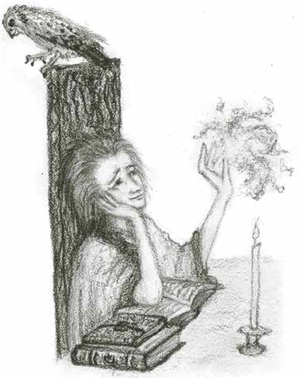
Steed of the Sorcerer posted:
The caster must sit perfectly still for the hour it takes to cast this ritual, uttering only a single, unintelligible word at the culmination: the name of his dark steed. He must then saddle his mount with a pristine, never used bridle and saddle of black leather, which will fade with the beast when it departs this world.
Love Potion posted:
A staple of every witch’s repertoire, the love potion’s strength will vary by maker. Our local wise woman’s brew made me fall in love with the next woman I saw; it took the work of another three witches to free my heart. The drinker is affected as though the target cast the False Friend spell.

